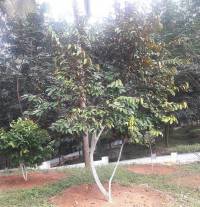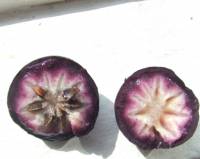Star apple
Botanical Information
| Botanical Information | |
|---|---|
| Order | Ericales |
| Family | Sapotaceae |
| Genus | Chrysophyllum |
| Common Name | Star apple |
| Species | C. cainito |
Maturity days
Planting Months
| Planting months | |||||||||||
|---|---|---|---|---|---|---|---|---|---|---|---|
| Jan | Feb | Mar | Apr | May | Jun | Jul | Aug | Sep | Oct | Nov | Dec |
| X | X | X | X | X | X | X | X | X | X | X | X |
Permaculture uses
| Permaculture uses | ||
|---|---|---|
| Usage 1 | Usage 2 | Usage 3 |
| Food_Forest | Fruit | |
Growing condition comments
| Growing Condition | Comment |
|---|---|
| Drought Tolerant | No |
| Humidity tolerant | Yes |
| Planting area | Ground |
| Sunlight | Full_sun |
Photos
Short comments
Tropical tree, grows in Townsville.
General comments
It grows rapidly and reaches 20 m in height. The leaves are evergreen, alternate, simple oval, entire, 5–15 cm long; the underside shines with a golden color when seen from a distance. The tiny flowers are purplish white and have a sweet fragrant smell. The tree is also hermaphroditic (self-fertile). It produces a strong odor. The fruit is globose and typically measures from 2 to 3 inches in diameter.
When ripe, it usually has purple skin with a faint green area appearing around the calyx. A radiating star pattern is visible in the pulp. Greenish-white and yellow-fruited cultivars are sometimes available. The skin is rich in latex, and both it and the rind are not edible. The flattened seeds are light brown and hard. It is a seasonal fruit bearing tree. The fruits are used as a fresh dessert fruit; it is sweet and often served chilled.
Infusions of the leaves have been used against diabetes and articular rheumatism. The fruit has antioxidant properties. The bark is considered a tonic and stimulant, and a bark decoction is used as an antitussive. The fruit also exists in three colors, dark purple, greenish brown and yellow. The purple fruit has a denser skin and texture while the greenish brown fruit has a thin skin and a more liquid pulp; the yellow variety is less common and difficult to find.


